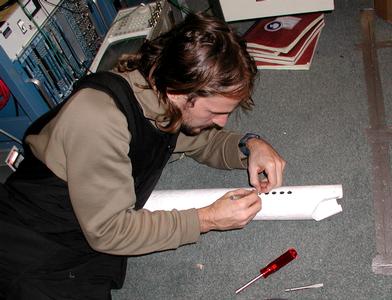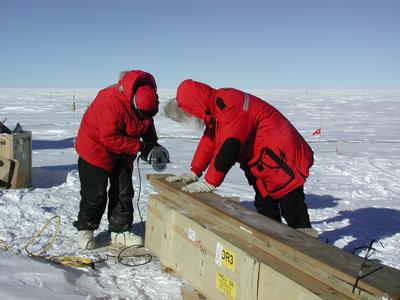26 November, 2001
A number of people have asked me why I keep posting biological and weather data each day at the conclusion of my journal. The weather data is solely for sharing the type of conditions I am working under, whereas the biological data is posted at the request of a teacher I work with named Karen Kutish.
The South Pole is 9,300 feet above sealevel. However, since the atmospheric pressure is so low, the perceived altitude is adjusted. This is similar to how temperature is adjusted with the windchill factor. Pressure changes with temperature, so today the perceived altitude is equivalent to 10,318 feet.
The amount of oxygen in the air goes down as you climb higher above sea level and becomes very low at altitudes above 8,000 feet. If the accent is taken very slowly, your body has time to adjust to the lower oxygen levels. However, since walking to the South Pole is usually not an option, people arriving here are frequently struck with altitude sickness.
One way to measure a bodies reaction to oxygen depletion is to measure their saturated oxygen levels. This is a simple test that measures the percentage of oxygen in your blood. The measurement is conducted by attaching a small clip to your index finger. The instrument sends a pulse through your finger and measures the reflection that is returned. The reflection measured will vary depending upon the amount of oxygen in your blood. Back in the civilized world, a person with 85% or less saturated oxygen in their blood would be admitted to the hospital. These are the levels typically found in people suffering from lung damage caused by smoking. In severe cases, it is often necessary for them to remain on oxygen for the remainder of thier lives.
There are three main types of high-altitude sickness: (1) acute mountain sickness (also called AMS), (2) high-altitude pulmonary edema (also called HAPE), which affects the lungs, and (3) high-altitude cerebral edema (also called HACE), which affects the brain. These illnesses can be serious, but they can also be prevented.
There are two important things to prevent high-altitude sickness: (1) take your time traveling to higher altitudes and (2) sleep at an altitude that is lower than the altitude you were in during the day. Both of these are not option at the South Pole.
Some of the first signs of high-altitude sickness are headache, lightheadedness, weakness, trouble sleeping, and an upset stomach. Most people arriving at the South Pole experience a few of these symptoms. Usually they go away after a few days after your body has adjusted. If a person does not improve, or the symptoms get worse, there are two things that can be done. First, you can be placed in special chamber that pumps in air so the conditions are similar to sealevel. Or, in an emergency, the person would have to be evacuated to McMurdo on the next available flight.
Currently, the only sympton I am experiencing is a lack of sleep. I was only able to sleep two hours last night. However, it is difficult to tell if this is due to the low oxygen levels or the continuous sunlight. Possibly, it is a combination of both. It is time to return to work. Today we will be working outside again to construct the platform that our detector will sit upon.
Biological Data
Saturated Oxygen: 85 %
Pulse Rate: 74
Weather Data
Temperature: -35 F
Windchill: -58.1 F

Cutting holes in the heating unit.

Sawing wood for the platform for the detector.
Contact the TEA in the field at
.
If you cannot connect through your browser, copy the
TEA's e-mail address in the "To:" line of
your favorite e-mail package.
|
